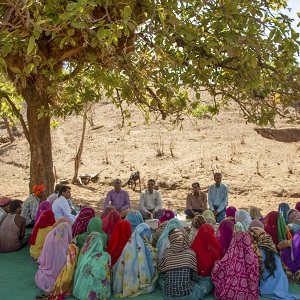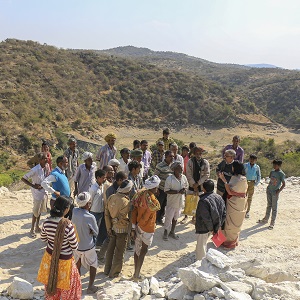and raised the matter with the panchayat as well as the sub-divisional magistrate. As a result of their careful supervision, an engineer was sent from Udaipur to check the quality of work. This was an eye-opener for local government officials, who realised that the GVC was quite correct. The construction was dismantled and foundations deepened. The whole building project was completed under the direct supervision of the Village Development Committee.
A village takes control
|
|
Rod ka Guda is a small village situated in the rocky area of Sukhar in Kumbhalgarh. This village consists of around 100 households with a population of 700. The village people have very few government services and have long had problems with drinking water. In addition to working on pastureland development and some soil and water conservation work, Seva Mandir has formed a Village Development Committee (GVC) as well as two women’s Self-Help Groups in the village. Recently Seva Mandir spent INR 429,000 (just over USD 6,000) on construction of a water tank and pipeline for the villagers under the supervision of the GVC members. The GVC then negotiated with the gram panchayat, successfully securing INR 100,000 (nearly USD 1,500) towards the purchase of a pump to help them lift water to the tank.
Now the GVC is taking primary responsibility for its management and maintenance. They have devised rules, fixed a token amount of INR 200 (just under USD 3) which each household must pay per month towards water service charges, and appointed a point person to operate the machine twice a day. The amount paid by households is being used for payment of the point person, electricity charges and other maintenance.
This case is notable for the collective effort and contribution of the GVC and also because they were able to persuade the panchayat to play a positive role in their development.
|

|
Federations changing lives
|
|
Regional federations are the highest level of governance structure in our hierarchy of community institutions. The federations’ main objective is to identify and work on common issues in their region. For this purpose, they liaise with various government as well as non-government agencies to arrange support with the issues at hand.
In April 2017, during the regular meetings of Kherwara regional federation, the representatives discussed the urgent need to alleviate the severe scarcity of drinking water in some of the villages. The representatives visited several villages, conducted surveys and put together around 60-70 proposals relating to work on drinking water facilities, involving repair of handpumps, digging of common wells and provision of water tankers. They registered these proposals with the relevant gram panchayats and requested their support and cooperation. They also sought help at Sub-District, Tehsil, and Block levels. As a result of their efforts, the respective gram panchayats implemented half of the proposals within a month and the rest are being attended to. This has benefited residents of around 10 villages who were facing extreme water shortages.
|

|
6go6ckt5b8|00008FF710A5|WWdSubPages|MainContent|98B5FBD8-9D6B-494C-AD22-EBB656B0DC21